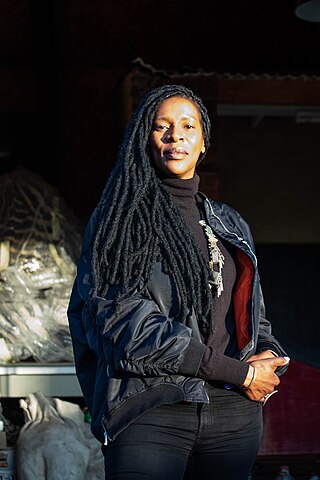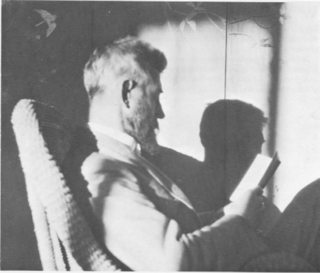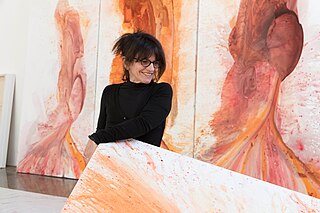David Goldblatt HonFRPS was a South African photographer noted for his portrayal of South Africa during the period of apartheid. After apartheid had ended he concentrated more on the country's landscapes. What differentiates Goldblatt's body of work from those of other anti-apartheid artists is that he photographed issues that went beyond the violent events of apartheid and reflected the conditions that led up to them. His forms of protest have a subtlety that traditional documentary photographs may lack: "[M]y dispassion was an attitude in which I tried to avoid easy judgments. . . . This resulted in a photography that appeared to be disengaged and apolitical, but which was in fact the opposite." He has numerous publications to his name.
Brett Murray is a South African artist mostly known for his steel and mixed media wall sculptures. He was born in Pretoria, South Africa. Murray has a master's degree in fine art from the Michaelis School of Fine Art, 1989. Referred to by critic Brenda Atkinson as "the dark prince of South African pop (art)", Murray is one of the country's most popular artists, often using easily recognisable media images with the addition of a subversive and bitterly funny twist. Murray's work addresses the wars of the cultures, the clash between Afrocentrism and Eurocentrism, the old and the new South Africas. "With my work I hope to critically entertain. Through satirical and tragic reflections on South Africa, I hope to shift people's perspectives and change people's minds, indulgent, arrogant and pretentious as this might sound," he says. More recently, his work has explored his own personal experiences and identity. Murray was also the founder of the sculpture department at Stellenbosch University.

Judith Mason born Judith Seelander Menge was a South African artist who worked in oil, pencil, printmaking and mixed media. Her work is rich in symbolism and mythology, displaying a rare technical virtuosity.

Joburg Art Fair is a contemporary art fair held annually in Johannesburg, South Africa. The first show took place from 13 to 16 March 2008. The second Joburg Art Fair is scheduled for 3 April to 5 April 2009.

Hermann Niebuhr is a South African artist who lives in De Rust. He utilizes oils on canvas in a classical painterly style to document urban decay as well as rural landscapes.
Tyrone Appollis is a South African artist and poet.
Matthew Hindley is a South African painter. He graduated from the Michaelis School of Fine Art, Cape Town in 2002, where he was awarded the Michaelis Prize.

Nandipha Mntambo is a South African artist who has become famous for her sculptures, videos and photographs that focus on human female body and identity by using natural, organic materials. Her art style has been self described as eclectic and androgynous. She is best known for her cowhide sculptures that connects the human form to nature.
Tom Cullberg is an artist born in Stockholm, Sweden, in 1972. He currently lives and works in Cape Town, South Africa.
Athi-Patra Ruga is a South African artist who uses performance, photography, video, textiles, and printmaking to explore notions of utopia and dystopia, material and memory. His work explores the body in relation to sensuality, culture, and ideology, often creating cultural hybrids. Themes such as sexuality,Xhosa culture, and the place of queerness within post-apartheid South Africa also permeate his work.

Pieter Willem Frederick Wenning was a South African painter and etcher, considered to be the progenitor of the style of Cape Impressionism.

Sue Williamson is an artist and writer based in Cape Town, South Africa.
Mary Sibande is a South African artist based in Johannesburg. Her art consists of sculptures, paintings, photography, and design. Sibande uses these mediums and techniques to help depict the human form and explore the construction of identity in a postcolonial South African context. In addition, Sibande focuses on using her work to show her personal experiences through Apartheid. Her art also attempts to critique stereotypical depictions of women, particularly black women.
Wim Botha is a South African contemporary artist.
Nel Erasmus is a South African artist, and is considered as one of South Africa's earliest abstract artists.

Penny Siopis is a South African artist from Cape Town. She was born in Vryburg in the North West province from Greek parents who had moved after inheriting a bakery from Siopis maternal grandfather. Siopis studied Fine Arts at Rhodes University in Makhanda, completing her master's degree in 1976, after which she pursued postgraduate studies at Portsmouth Polytechnic in the United Kingdom. She taught Fine Arts at the Technikon Natal in Durban from 1980 to 1983. In 1984 she took up a lectureship at the University of the Witwatersrand in Johannesburg. During this time she was also visiting research fellow at the University of Leeds (1992–93) and visiting professor in fine arts at Umeå University in Sweden (2000) as part of an interinstitutional exchange. With an honorary doctorate from Rhodes University, Makhanda – Siopis is currently honorary professor at Michaelis School of Fine Art, University of Cape Town.
Lionel Smit is a South African artist, known for his contemporary portraiture executed through large canvases and sculptures.
Carl Walter Meyer was an artist born in Aliwal North, Eastern Cape. Meyer graduated from the University of Pretoria with a degree in Fine Art. He furthered his studies at the "Staatliche Kunstakademie” in Düsseldorf, Western Germany, under professor Michael Buthe. He was living in Upington, Northern Cape at the time of his death.
Mmakgabo Mmapula Mmangankato Helen Sebidi is a South African artist born in Marapyane (Skilpadfontein) near Hamanskraal, Pretoria who lives and works in Johannesburg. Sebidi's work has been represented in private and public collections, including at the National Museum of Women in the Arts, Washington and New York the Smithsonian National Museum of African Art, New York, and the World Bank. Her work has been recognised internationally and locally. In 1989 she won the Standard Bank Young Artist award, becoming the first black woman to win the award. In 2004, President Thabo Mbeki awarded her the Order of Ikhamanga in Silver – which is the highest honor given to those considered a "national treasure". In 2011, she was awarded the Arts and Culture Trust (ACT) Lifetime Achievement Award for Visual Art, whilst in 2015 she received the Mbokodo Award. In September 2018, Sebidi was honoured with one of the first solo presentations at the Norval Foundation in Cape Town – a retrospective entitled Batlhaping Ba Re.
Bongiwe or Bongi Dhlomo-Mautloa, is a Zulu South African printmaker, arts administrator and activist.









